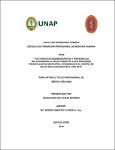Factores sociodemográficos y personales relacionados al inicio tardío de las atenciones prenatales en gestantes, atendidas en el Centro de Salud San Juan Bautista, año 2018
Abstract
incrementan el riesgo de inicio tardío de las atenciones prenatales en
gestantes atendidas en el Centro de Salud San Juan Bautista, año 2018.
Metodología: se realizó un estudio de tipo observacional, analítico
retrospectivo de diseño caso-control; se analizó a 150 gestantes o
puérperas, 50 que iniciaron tardíamente su APN y 100 controles; el análisis
inferencial de asociación se realizó mediante el cálculo de Chi2 con su
respectiva significancia p<0.05, para el análisis de riesgo se usó OR con su
respectivo intervalo de confianza; y para el análisis multivariado se usó la
regresión logística.
Resultados: la población en estudio es muy joven ya que la mitad de ellas
son adolescentes, y 22% adultas jóvenes de 20 a 24 años, la gran mayoría
eran convivientes durante el estudio, y más de la mitad culminaron la
secundaria, cabe señalar que un gran porcentaje solo culminó la primaria;
la gran mayoría eran amas de casa y en casi la totalidad provenían de
zonas urbanas; también se demostró que la mayoría eran nulíparas o
primíparas. En cuanto al análisis bivariado tanto la edad adolescente (2.08;
IC: 1.03 - 4.19), grado de instrucción deficiente (2.03; IC: 1.01 - 4.06), así
como también el antecedente de APN tardía en gestaciones anteriores
(OR: 4.33; IC: 2.06 – 9.08), mostrar interés en la APN (2.92; IC: 1.36 –
6.24), y considerar que la APN es importante (3.64; IC: 1.55 – 8.57),
mostraron estar relacionados al inicio tardío de la APN. Sin embargo en el
análisis multivariado por medio de regresión logística solo la edad
adolescente y el antecedente de inicio tardío de APN en gestaciones
anteriores incrementan el riesgo de una nueva APN tardía.
Conclusiones: existen factores de riesgo para el inicio tardío de la APN
sobre todo la edad adolescente y el antecedente de inicio tardío de la
misma en gestaciones anteriores. Objective: determine the sociodemographic and personal factors that
increase the risk of late onset of prenatal care in pregnant women attended at
the San Juan Bautista Health Center, year 2018.
Methodology: An observational, retrospective analytical study of case-control
design was carried out; 150 pregnant or puerperal women were analyzed, 50
who started their APN late and 100 controls; the inferential association
analysis was performed by calculating Chi2 with its respective significance p
<0.05, for the risk analysis OR was used with its respective confidence interval;
and for the multivariate analysis, logistic regression was used.
Results: The study population is very young since half of them are teenagers,
and 22% young adults from 20 to 24 years old, the vast majority were living
together during the study, and more than half completed high school, it should
be noted that a large percentage only completed the primary; the vast majority
were housewives and almost all came from urban areas; It was also shown
that the majority were nulliparous or primiparous. Regarding the bivariate
analysis, both adolescent age (2.08; CI: 1.03-419), poor degree of instruction
(2.03; CI: 1.01-4.06), as well as the history of late APN in previous gestations
(OR: 4.33; CI : 2.06 - 9.08), show interest in the NPC (2.92; CI: 1.36 - 6.24),
and consider that the NPC is important (3.64; CI: 1.55 - 8.57), were shown to
be related to the late onset of the NPC. However, in the multivariate analysis
by means of logistic regression, only the adolescent age and the antecedent
of late onset of NPCs in previous pregnancies increase the risk of a new late
NPC.
Conclusions: There are risk factors for the late onset of the NPC, especially
the adolescent age and the history of late onset of it in previous pregnancies.
Collections
- Tesis [349]
The following license files are associated with this item:


